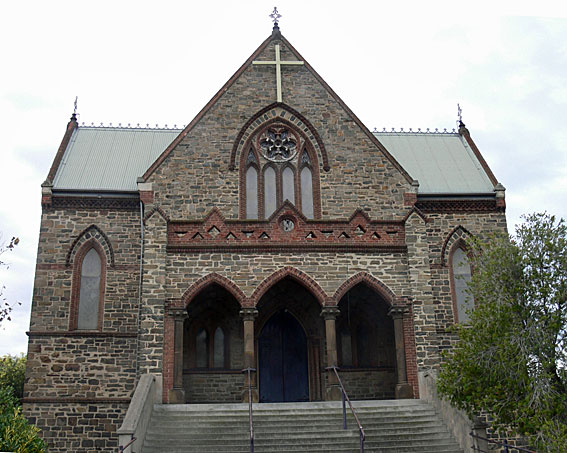
Uniting Church, Port Adelaide: exterior
[Photograph by John Maidment (13 June 2012)]

Uniting Church, Port Adelaide: exterior
[Photograph by John Maidment (13 June 2012)]
Historical and Technical Documentation by David Shield
© OHTA 2013 (last updated September 2013)
The former Congregational, now Uniting, Church in Port Adelaide stands testimony to the mid-19th century faith of that denomination in the Port Adelaide district. Typically, services had begun in a small way. The Revd T.Q. Stow conducted services at Port Misery in 1838. Services continued on the wharves in 1839 with the help of Mr J.J. Barclay and William Giles. Later services were held in a warehouse and, in 1847, a sail loft. A stone chapel was erected in 1851 but destroyed by fire in 1866. The current church was erected and opened on 13 December 1868.1 The organ followed in 1884.
In April of 1868 a fire gutted the first Congregational Chapel. Having started in the chimney from the schoolroom beneath the church where the chapel keeper was preparing a tea, it spread to the roof. Incompetence and lack of water prevented the extinguishing of the flames and the building was burnt to the ground over a period of five hours. The harmonium was saved but most furniture was mishandled and damaged. The inquest concluded the fire was accidental.2
Rather than rebuild it was decided to relocate and build on the current block of land, the previous being too restrictive. Mr James Macgeorge's plan was chosen, and Mr Reynolds' tender accepted to complete the building at a cost of £3,500. Fitting out the church and other work added a further £500 to the price.
The new church was crowded for the opening services in December. It was estimated that 1,000 people were at the evening service though the building was only designed to comfortably seat 700. A complete description of the building and its fittings was given in the press:
It is in the Gothic style of architecture, Dry Creek stone being used, with plain and moulded brick dressings, and cornices. The approach is by a broad flight of steps, fronting the Commercial-road, and terminating in a porch of three arches, above which is a fine gable and handsomely stained-glass window. The front is flanked on the sides by smaller projecting gables, facing right and left, in which the staircases to the gallery are situated. The side elevations are terminated by projecting gables containing in the front six windows' in each tier. The schoolroom is situated below the upper tier, and is lighted by six windows. The rear has an octagonal apsis of 30 feet diameter in the centre, and flanked by projecting gables similar to the front. The roof is composed of slate ornamentally disposed, with tasteful crest tiling. The interior ts 85 feet by 40, and 50 feet between the transepts. Behind the platform is a large octagonal recess, continued upwards to the ceiling, and ornamented with pillars and arches. The ceiling is richly panelled and supported on ornamental wall-posts, and moulded figures representing cherubims, and the windows are composed of white glazed and richly stained glass. The church, including the gallery, comfortably seats 700 people,… The acoustic properties of the church have turned out admirably, … The platform and pulpit are in front of a recess under the apsis, which is ornamented with four polished cedar pillars, having moulded bases, and handsome caps. An ornamental railing is fixed round the platform, and a handsome bronze railing of bold and elegant design is carried round the communion table. The reading desks, pulpit, and sittings are of carved cedar, and the furniture generally in good taste. There is nothing in the character of the embellishments which would tend to distract the attention of the congregation whilst at worship, and the whole effect is of a light, cool, and pleasing aspect. The gas fittings are simple and appropriate. The schoolroom below is 62 feet by 50 feet wide, and 12 feet high, and on the same floor is situated a class-room and vestry, with a staircase leading thereto.3
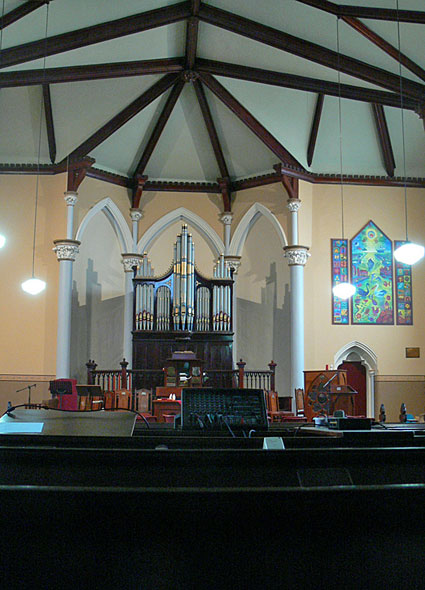
Uniting Church, Port Adelaide: interior
[Photograph by John Maidment (13 June 2012)]
The first proposal to purchase a pipe organ for the Congregational church in Port Adelaide would appear to be in January of 1881 with fund raising over the next two years.4 In July 1883, Arthur Hobday attended a committee meeting to discuss terms of payment. He had clearly been asked to supply specifications of an organ for the church. Fincham & Hobday were to agree to build an organ in accordance with specifications of the third scheme dated 11 January 1883. For their part the organ committee agreed to pay £416.10.0 as follows: £55.10 with the order £150 on completion in the church £100 by approved bill three months after completion and a final £100 with interest from completion in the church, a further three months later.5 The following day Hobday wrote to Fincham that:
…The Port Congregational Church Job is almost settled I may safely say it is ours but I have stipulated for a percent with the order as they want terms, all that is wanted to complete the contract is their cheque, so you see I am booked here for some time. …6
In April the following year Hobday wanted to know when he could expect the material "for the Port job" as the church wanted to fix the opening for the first Sunday in June and he wanted to give the Committee an answer.7 The Committee had asked W.B. Chinner of Pirie Street Methodist Church to open the organ. This he consented to do in conjunction with Mr Channon the incumbent organist and the choir. In the event he was able to postpone the opening till the 24 June when it was opened with a grand sacred concert and recital.
The evening was wet. Although there was a "fairly numerous and decidedly appreciative audience" the programme was repeated two weeks later when there was "a very large audience". Analysis of the programme was forthcoming but neither press report made comment about the organ itself.8

Uniting Church, Port Adelaide: organ
[Photograph by John Maidment (13 June 2012)]
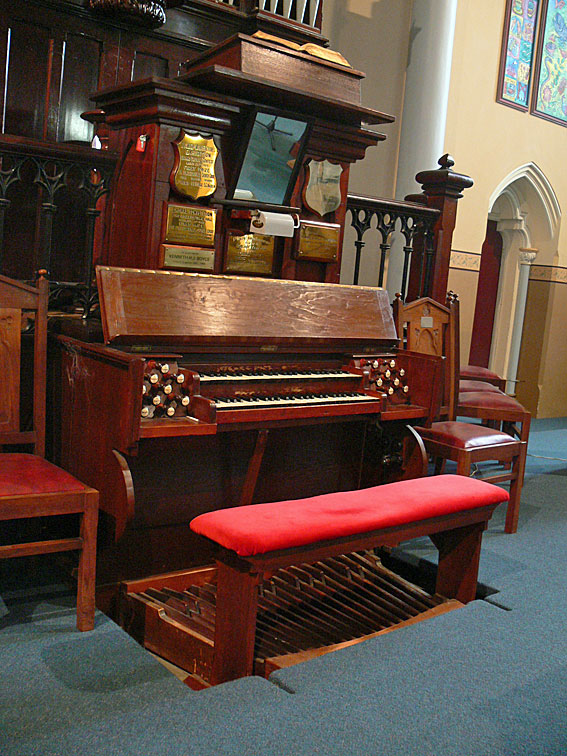
Uniting Church, Port Adelaide: console
[Photograph by John Maidment (13 June 2012)]
Channon resigned in 1888 owing to ill health but was reappointed in 1896 to replace A.W. Mortimer who had died in October. Channon finally resigned in February 1899 and was succeeded by E.V. Little who had been at Semaphore Baptist Church. Little remained till 1906 before transferring to Woodville Methodist.
During Little's incumbency an electric motor had been installed to provide wind to the bellows. Unsuited to its task it was to provide ongoing problems for some years. During the incumbency of Frank Hancock, from 1907, friction with the organbuilder was evident. The very existence of the organ was threatened with a new organ being proposed. In 1908 the Electric Lighting Co. installed a new motor for the wind. J.E. Dodd had advised against it and was asked to return his key thus being denied easy access. By 1910 it would seem that the blower was still giving problems. It was a forge type blower, not provided by Dodd and was noisy and inefficient. Fairly terse letters were obviously exchanged, but the situation eventually resolved.9
The pressure for change came from another source. In 1911 the Sheffield Choir were to visit Adelaide with performances in the Exhibition Building. Dodd had been asked to supply an organ for the event and used the occasion to put pressure on the church to build a new organ to be used, initially for one week with the Choir, before placement in the church. Several specifications were nominated.10 Nothing was to come of it.
Edward Gare was appointed to replace C.W. Barton in August 1933. Gare was only to stay for 11 months before moving on to the Glenelg Congregational Church.11 Nevertheless in that short time he had the organ pedals replaced.12
In July 1940 D.H. Grosvenor became ill and died the following January. Ken Boyce was appointed. Initially in an acting capacity, this became permanent in February 1941. He was to remain until his retirement in 1993. He died only last year.13
Like other organs this instrument suffered the "white paint craze." Exactly when or why this occurred is unclear but there was a period when it was fashionable to paint organ pipes white, as was done with the Adelaide Town Hall organ in 1935. Last year a group from the church determined to discover the original decoration and, under the guidance of an artist, a group of volunteers have reproduced the stunning display we see today. The casework is very similar to the Fincham & Hobday instruments at the Uniting Church, Mt Barker, and in Victoria at the Uniting Church, Balaclava and the Reformed Church of Geelong, Newtown. The metal pipework remains cone tuned, so it is clear that the original pitch and voicing has been preserved.
| GREAT Open Diapason Clarabella Dulciana Principal Flute Piccolo Mixture Swell to Great SWELL Dou diapason Open Diapason Stop Diapason Keraulophon Gemshorn Flageolet Oboe Tremulant PEDAL Bourdon Great to Pedal Swell to Pedal |
8 8 8 4 4 2 2 rks 16 8 8 8 4 2 8 16 |
(gvd) open CC 19,22 / Mid c 15.19/ Oct F sharp 12.15 (TC) (gvd) (by trigger pedal) |
Compass 56/30
Trigger swell pedal
Detached drawknob console
free standing in apse behind pulpit
3 composition pedals to great
1 Cameron J., In Stow's Footsteps pp. 8, 9, 18, 39, 43, 126; Chronicle and Weekly Mail 19/12/1868 p.5
2 Register 1/5/1866 p.3; Advertiser 2/5/1866 p3; Register 2/5/1866 p.3
3 Chronicle and Weekly Mail 19/12/1868 p.5
4 Port Adelaide Congregational Church, Extracted minutes re Music Choir and Organ, 31/1/1881 (Church document); Christian Colonist 1/6/1883 p.3
5 extracted minutes op cit July 11 1883
6 F&H Letters 12/76 12/7/1883, Hobday to Fincham
7 ibid 12/87,88 16/4/1884, Hobday to Fincham.
8 Register 25/6/1884 p.5; Advertiser 9/7/1884 p.7
9 DLB Vol 4 1903-1909 D.E. Dodd to Mr F. Cockington, p.1007 14/5/1906; ibid Vol 8 1909-14 D.E. Dodd to Dr Godson, 27/7/1915, pp.419-421
10 DLB Volume 9 1910-12 D.E. Dodd to C. Hodge, 26/7/1910, pp. 241-243, 282-283; ibid D.E. Dodd to Mr Hancock 7/9/1910 pp. 522-525
11 State Library South Australia SRG 95 133/2 v2 Glenelg Congregational Church Minutes of Deacon's Meetings Jan 1912 – Aug 1938, 25/7/1934 p.302
12 extracted minutes op cit 28/11/1933
13 ibid 30/7/1940, 28/1/1941; The Gateway 30/8/1946 p.7 Church Histories No 1 Port Adelaide Congregational
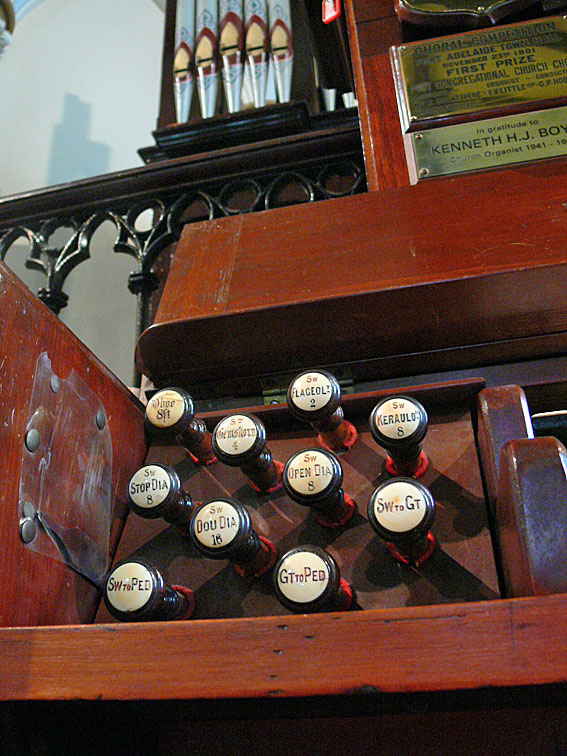
Uniting Church, Port Adelaide: left-hand stop jamb
[Photograph by John Maidment (13 June 2012)]
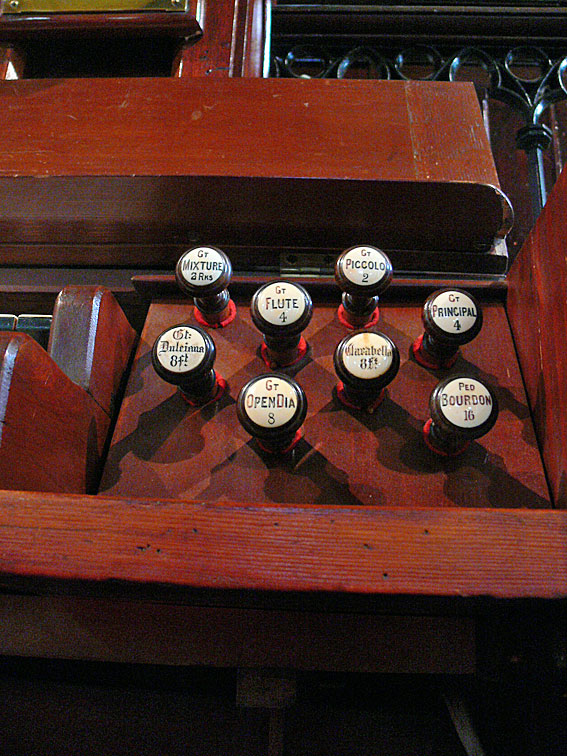
Uniting Church, Port Adelaide: right-hand stop jamb
[Photograph by John Maidment (13 June 2012)]

Uniting Church, Port Adelaide: an early photograph of the interior and organ
[Photograph from the collection of John Maidment]